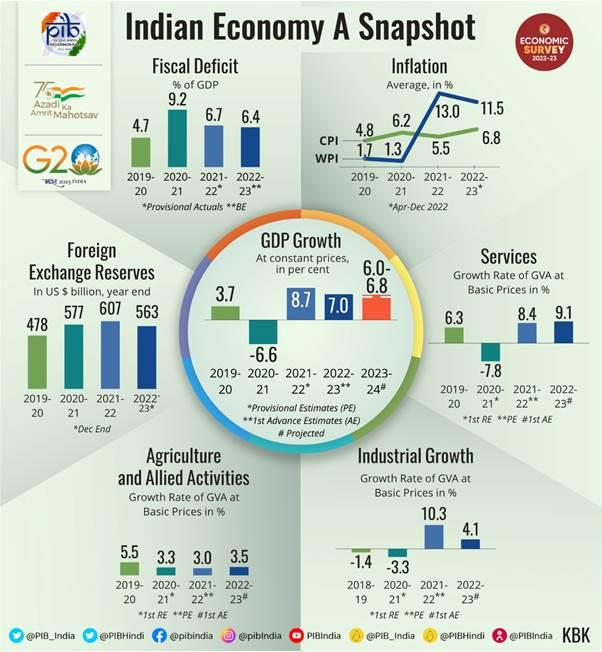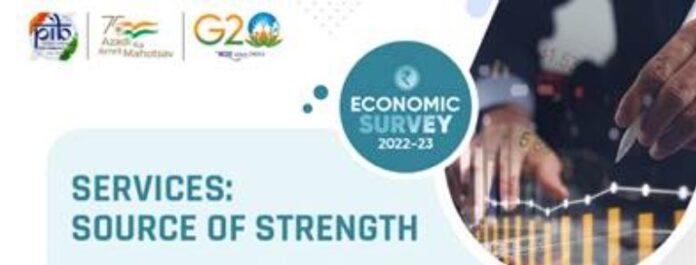Economic Survey 2022-23: The Indian economy is showing signs of a broad-based recovery across sectors, as the country positions itself to return to its pre-pandemic growth trajectory in the fiscal year 2022-23. The Economic Survey 2022-23, released recently, outlines the key economic developments and reforms undertaken by the government to boost growth and improve the standard of living in India.
Retail inflation has returned to the target range set by the Reserve Bank of India (RBI) in November 2022, while direct tax collections for the period April-November 2022 have remained robust. There has been an improvement in employment, as evidenced by the declining urban unemployment rate and increased net registration in the Employee Provident Fund.
The focus of the government reforms is on creating public goods and services, improving agricultural productivity, and promoting the private sector as a development partner. The cleaner balance sheets of financial institutions have led to increased lending, while the growth in credit offtake and private capital expenditures are expected to drive a virtuous investment cycle.
The gross non-performing assets (GNPA) ratio of Scheduled Commercial Banks (SCBs) has fallen to a seven-year low of 5.0, while non-food credit offtake by SCBs has been growing in double digits since April 2022. The combined social sector expenditure of the central and state governments has increased to Rs. 21.3 lakh crore in the fiscal year 2022-23, with a heightened focus on the health sector.
India has administered more than 220 crore COVID vaccine doses and has launched the “LIFE” movement to promote a more environmentally-friendly lifestyle. The country has also made a “Net Zero Pledge” to achieve net-zero emissions by 2070 and has established the National Green Hydrogen Mission to become energy independent by 2047.
The private investment in agriculture has increased to 9.3% in 2020-21, with free food grains provided to 81.4 crore beneficiaries under the National Food Security Act for one year. Over 11.3 crore farmers were covered under the PM KISAN program in its April-July 2022-23 payment cycle, and India is at the forefront of promoting millets through the International Year of Millets initiative.
Investment of ₹47,500 crores has been made under the Production Linked Incentive (PLI) schemes in the fiscal year 2022, exceeding the designated target for the year. India’s e-commerce market is projected to grow at an annual rate of 18% through 2025, and the country is the largest recipient of remittances globally, receiving US$ 100 billion in 2022. The PM GatiShakti National Master Plan has created a comprehensive database for integrated planning and synchronised implementation across government departments.
UPI-based transactions have grown in both value (121%) and volume (115%) terms between 2019-2022, paving the way for its international adoption. The Economic Survey 2022-23 highlights the positive developments and reforms underway in India, pointing to a bright future for the country’s economy.
IMF, in its World Economic Outlook Update, has maintained India’s GDP forecast for current FY at 6.8%, next FY at 6.1% and for 2024-25 at 6.8%. India’s economy is poised to do better in the remainder of this decade – Chief Economic Advisor V . Anantha Nageswaran
Economic Survey 2022-23 rebound of private consumption boosts growth curve

The optimistic growth forecasts stem from a number of positives like the rebound of private consumption given a boost to production activity, higher Capital Expenditure (Capex), near-universal vaccination coverage enabling people to spend on contact-based services, such as restaurants, hotels, shopping malls, and cinemas, as well as the return of migrant workers to cities to work in construction sites leading to a significant decline in housing market inventory, the strengthening of the balance sheets of the Corporates, a well-capitalised public sector banks ready to increase the credit supply and the credit growth to the Micro, Small, and Medium Enterprises (MSME) sector to name the major ones.
he Survey says, in real terms, the economy is expected to grow at 7 per cent for the year ending March 2023. This follows an 8.7 per cent growth in the previous financial year.
Despite the three shocks of COVID-19, Russian-Ukraine conflict and the Central Banks across economies led by Federal Reserve responding with synchronised policy rate hikes to curb inflation, leading to appreciation of US Dollar and the widening of the Current Account Deficits (CAD) in net importing economies, agencies worldwide continue to project India as the fastest-growing major economy at 6.5-7.0 per cent in FY23.



